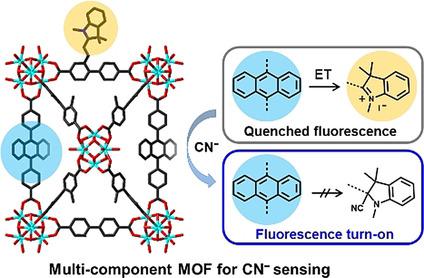当前位置:
X-MOL 学术
›
Angew. Chem. Int. Ed.
›
论文详情
Our official English website, www.x-mol.net, welcomes your
feedback! (Note: you will need to create a separate account there.)
Stepwise Assembly of Turn-on Fluorescence Sensors in Multicomponent Metal-Organic Frameworks for in Vitro Cyanide Detection.
Angewandte Chemie International Edition ( IF 16.1 ) Pub Date : 2020-03-15 , DOI: 10.1002/anie.202000702 Jialuo Li 1 , Shuai Yuan 1 , Jun-Sheng Qin 1 , Jiandong Pang 1 , Peng Zhang 1 , Yingmu Zhang 1 , Yanyan Huang 1 , Hannah F Drake 1 , Wenshe R Liu 1 , Hong-Cai Zhou 1
Angewandte Chemie International Edition ( IF 16.1 ) Pub Date : 2020-03-15 , DOI: 10.1002/anie.202000702 Jialuo Li 1 , Shuai Yuan 1 , Jun-Sheng Qin 1 , Jiandong Pang 1 , Peng Zhang 1 , Yingmu Zhang 1 , Yanyan Huang 1 , Hannah F Drake 1 , Wenshe R Liu 1 , Hong-Cai Zhou 1
Affiliation

|
The controlled synthesis of multicomponent metal–organic frameworks (MOFs) allows for the precise placement of multiple cooperative functional groups within a framework, leading to emergent synergistic effects. Herein, we demonstrate that turn‐on fluorescence sensors can be assembled by combining a fluorophore and a recognition moiety within a complex cavity of a multicomponent MOF. An anthracene‐based fluorescent linker and a hemicyanine‐containing CN−‐responsive linker were sequentially installed into the lattice of PCN‐700. The selective binding of CN− to hemicyanine inhibited the energy transfer between the two moieties, resulting in a fluorescence turn‐on effect. Taking advantage of the high tunability of the MOF platform, the ratio between anthracene and the hemicyanine moiety could be fine‐tuned in order to maximize the sensitivity of the overall framework. The optimized MOF‐sensor had a CN−‐detection limit of 0.05 μm , which is much lower than traditional CN− fluorescent sensors (about 0.2 μm ).
中文翻译:

在用于氰化物体外检测的多组分金属有机框架中逐步组装开启式荧光传感器。
多组分金属-有机框架(MOF)的受控合成可以在框架内精确定位多个协作官能团,从而产生新的协同效应。在本文中,我们证明可以通过在多组分MOF的复杂腔体内组合荧光团和识别部分来组装开启型荧光传感器。基于蒽的荧光接头和一个含CN半花青- -响应性接头依次安装到PCN-700的晶格。选择性CN结合-半胱氨酸的抑制作用抑制了两个部分之间的能量转移,从而产生了荧光开启效应。利用MOF平台的高可调性,可以微调蒽和半菁部分之间的比例,以最大程度地提高整个框架的敏感性。优化的MOF-传感器有一个CN - 0.05μ -检测极限米,这比传统的CN非常低-荧光传感器(大约0.2μ米)。
更新日期:2020-03-15
中文翻译:

在用于氰化物体外检测的多组分金属有机框架中逐步组装开启式荧光传感器。
多组分金属-有机框架(MOF)的受控合成可以在框架内精确定位多个协作官能团,从而产生新的协同效应。在本文中,我们证明可以通过在多组分MOF的复杂腔体内组合荧光团和识别部分来组装开启型荧光传感器。基于蒽的荧光接头和一个含CN半花青- -响应性接头依次安装到PCN-700的晶格。选择性CN结合-半胱氨酸的抑制作用抑制了两个部分之间的能量转移,从而产生了荧光开启效应。利用MOF平台的高可调性,可以微调蒽和半菁部分之间的比例,以最大程度地提高整个框架的敏感性。优化的MOF-传感器有一个CN - 0.05μ -检测极限米,这比传统的CN非常低-荧光传感器(大约0.2μ米)。











































 京公网安备 11010802027423号
京公网安备 11010802027423号